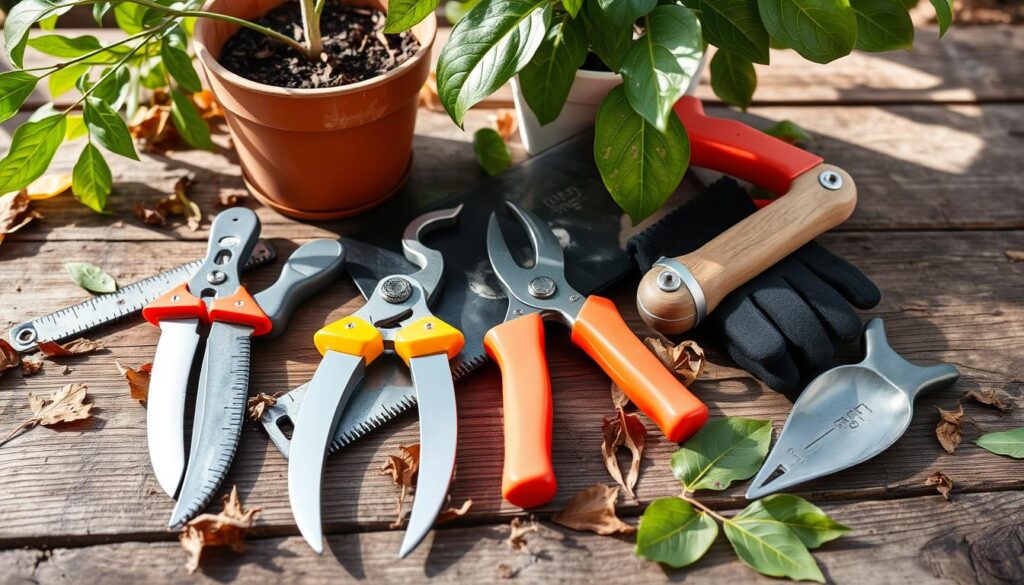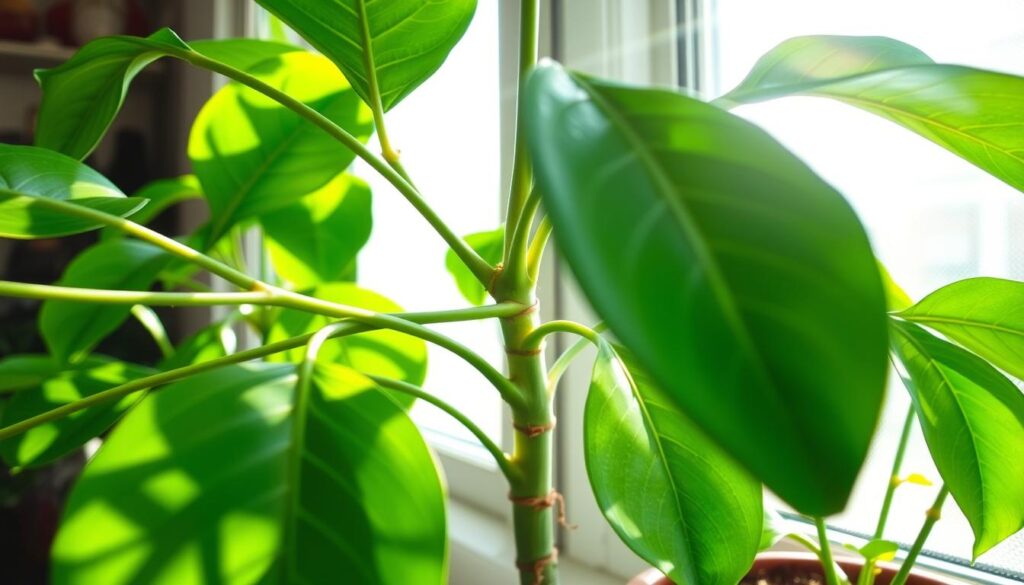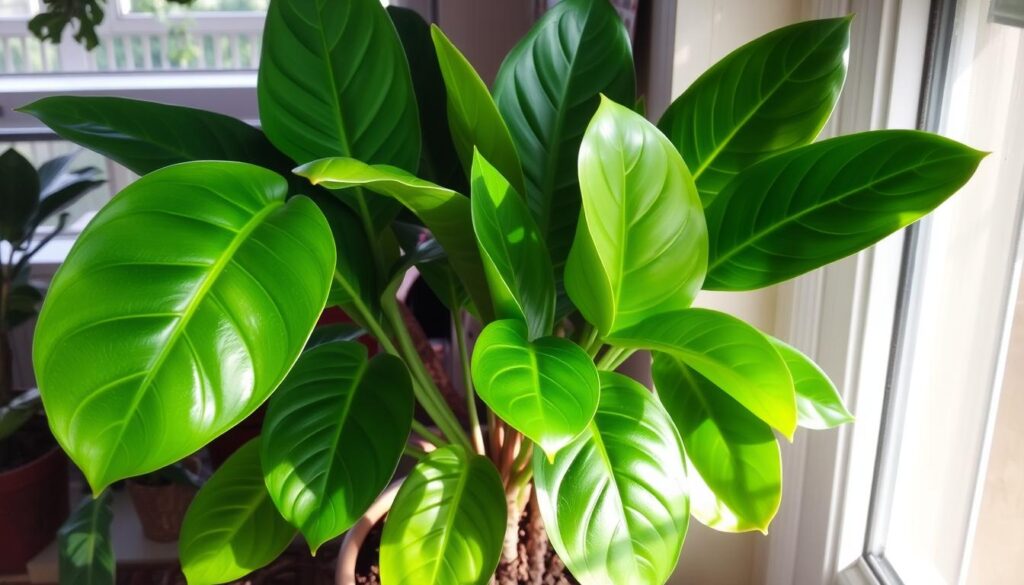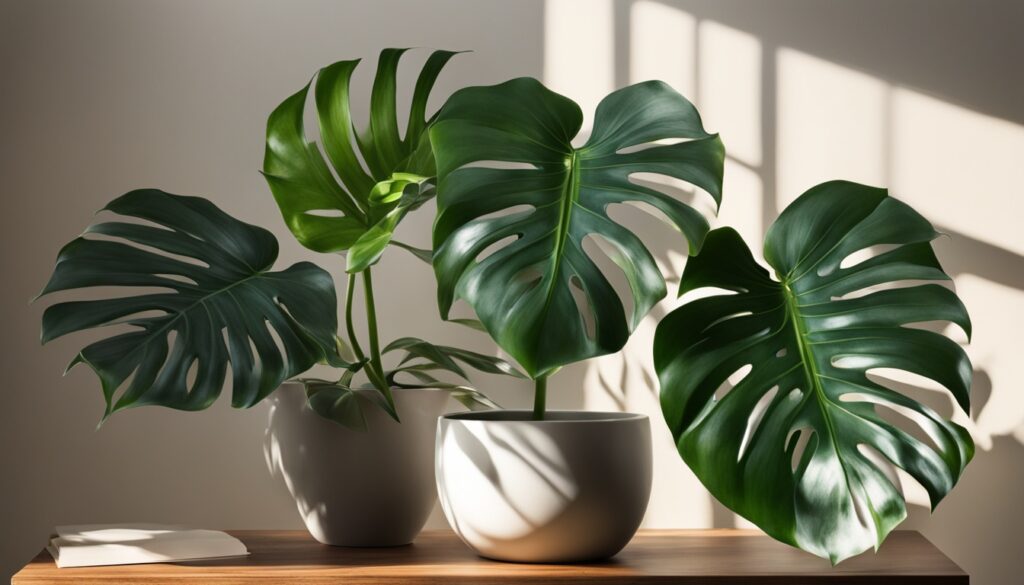Can a simple pruning session transform your indoor rubber plant into a lush, thriving masterpiece? Absolutely! Proper pruning is the key to unlocking your Ficus elastica’s full potential. It helps control its rapid growth and promotes a tidy, aesthetically pleasing appearance. But do you know the right techniques to keep your rubber plant happy and healthy?
Rubber trees can grow up to 60 cm per year. They need regular pruning to control growth, promote bushiness, and remove dead or diseased branches. Pruning should be done in late spring or early summer. The techniques vary based on the desired outcome, whether for growth control, shaping, aesthetics, or propagation.
Proper tools like sharp pruning shears or a fine-toothed saw are essential. They help make clean cuts and maintain the health and appearance of rubber plants.
Key Takeaways
- Rubber plants can grow up to 60 cm per year, requiring regular pruning to maintain their shape and size.
- Pruning is best done in late spring or early summer when the plant is actively growing.
- Proper pruning techniques can control growth, promote bushiness, and remove dead or diseased branches.
- Using clean, sharp tools is crucial for making clean cuts and preventing disease spread.
- Rubber plants are tolerant of pruning, making them ideal for shaping and size control.
Understanding Your Rubber Plant’s Growth Patterns
To care for your rubber plant, knowing its growth patterns is key. These plants can grow up to 100 feet tall in the wild. But indoors, they stay much smaller. With the right care, you can have a healthy rubber plant that looks great in your home.
Natural Growth in Wild vs Indoor Environment
In the wild, rubber trees can grow up to 130 feet tall. Their trunks can be as wide as 6.5 feet. But indoors, they are much smaller, reaching 6 to 10 feet tall and 3 to 5 feet wide. This shows how well rubber plants adapt to different environments.
Growth Rate and Size Expectations
Rubber plants grow 1 to 2 feet a year under the right conditions. Their size depends on light and water. Indoors, they take 5 to 10 years to reach full size. Proper pruning and pot size can also affect their growth.
Every rubber plant is different. Tailoring your care to its needs will help it thrive. By understanding how they grow, you can have a beautiful rubber plant that adds to your home’s beauty.
Essential Tools and Safety Equipment for Pruning
To keep your rubber plant healthy and vibrant, you need the right tools and safety gear. Having the right equipment is key for a successful and safe pruning session.
First, you’ll need clean, sharp pruning shears or a high-quality knife. Make sure to sterilize them before and after use to avoid spreading diseases or pests. Wearing protective gloves is also a good idea to protect your hands from the plant’s sticky sap.
Place a tarp or newspaper under the plant to catch any sap drips. This makes cleaning up easier. Having rubbing alcohol nearby is also helpful for cleaning tools and treating any problems found during pruning.
| Tool | Maintenance Tips |
|---|---|
| Pruning Shears | Sharpen blades regularly, wipe clean with rubbing alcohol after each use |
| Knife | Use a dedicated, sharp blade for pruning, sterilize before and after use |
| Gloves | Choose durable, cut-resistant gloves to protect hands from sap and thorns |
| Tarp or Newspaper | Lay down to catch sap drips and ease cleanup |
| Rubbing Alcohol | Use to sterilize tools and treat any pest or disease issues discovered |
With the right tools and safety gear, pruning your rubber plant will be smooth and successful. Always put safety first and keep your tools in good condition for the best results.

“Proper tool selection and maintenance can help prevent a large majority of injuries.”
Best Time to Prune Your Rubber Plant
Keeping your rubber plant healthy and looking good needs careful pruning at the right time. The best time to prune is late spring to early summer. This matches the plant’s active growth period, perfect for big cuts and new growth.
Seasonal Timing Considerations
Winter is great for big pruning houseplants because sap flow is low. But for rubber plants, late spring to early summer is best. This is when the plant grows fast, making it easier for it to heal and grow new leaves.
Growth Phase Assessment
Watching how your rubber plant grows helps you know when to prune. Look for new leaves and stems. Pruning then helps the plant grow stronger and look better.
Evening vs. Daytime Pruning
When you prune your rubber plant matters too. Evening pruning is better because it causes less sap to flow. This makes it cleaner and less stressful for the plant.
By considering the season, growth, and timing, you can keep your rubber plant thriving. Knowing these tips helps your plant stay healthy and look great. For more info, check out this guide on pruning.
Pruning a Rubber Plant: Step-by-Step Guide
Proper pruning is key for your rubber plant’s health and look. Focus on trimming at the right time. Start by cutting off dead, damaged, or diseased branches to encourage new growth.
To control height, trim the crown to your desired height. Make clean cuts just above nodes (small bumps on the trunk). For bushier growth, cut above nodes to stimulate side shoots.
If you want the plant to grow upward, prune back side shoots. Always use sharp, clean pruning shears. Make cuts at a 45-degree angle just above nodes for quick healing and growth. Wipe down tools with a moist cloth between cuts to prevent disease.
For large cuts, seal the area with wax or a plastic compound to protect the plant. Remove fallen leaves or debris around the base to prevent pests and diseases. With proper pruning, you can shape your rubber plant, control its size, and promote healthy growth.

“Pruning a rubber plant is like giving it a fresh start – it helps the plant focus its energy on new, vibrant growth rather than maintaining dead or damaged foliage.”
The best time to prune your rubber plant is from early spring to early summer. Avoid pruning in winter when the plant is dormant. Follow these steps to keep your rubber plant thriving and looking great. For more tips, check out this comprehensive guide on pruning pothos, which can help with your rubber plant care.
Managing Sap Flow During Pruning
Pruning a rubber plant means dealing with its milky white sap. This sap can irritate skin and stain surfaces. To manage sap flow, take precautions and clean properly.
Protective Measures
- Wear sturdy gardening gloves to avoid sap contact.
- Wear old clothes that you don’t mind getting sap on.
- Keep a damp cloth or paper towels ready to wipe sap drips.
Cleaning and Sap Removal
If sap touches your skin, wash it with soap and water right away. For furniture or floors, rubbing alcohol can remove stains. Let plant cuts dry before sealing to stop sap flow.
By following these steps, you can handle sap flow during pruning. This keeps your workspace clean and safe for your rubber plant. Remember, sap can irritate, so be careful.
| Pruning Tip | Recommendation |
|---|---|
| Protective Gear | Wear gloves and old clothes |
| Sap Removal | Use soap and water or rubbing alcohol |
| Cut Area Treatment | Allow to dry naturally before sealing |
Managing sap flow during pruning rubber plants is key for a clean workspace. Follow these tips for a smooth pruning experience with your rubber plant.
Promoting Healthy Branch Development
More than just pruning is needed for a thriving rubber plant. To get robust branch growth and the right shape, focus on certain techniques. These help the plant grow healthily.
Begin by pruning above the nodes for new growth. This method guides the plant’s energy to the desired areas. Also, remove any branches that compete to focus the plant’s energy.
Trimming longer side shoots helps keep the shape balanced and symmetrical. This process, called pinching, encourages bushier growth. It makes the plant look more compact and beautiful.
Make sure your rubber plant gets enough light all over. Good lighting nourishes the plant and prevents uneven growth.
Rubber plant propagation helps promote healthy branch growth too. By rooting stem cuttings, you get new, strong plants. They add to your rubber plant collection’s lush look.
“Proper pruning and cultivation techniques are essential for encouraging robust, balanced growth in rubber plants. With a little care and attention, you can create a thriving, visually stunning specimen that will be the envy of all your plant-loving friends.”

The secret to healthy branch growth in your rubber plant is a mix of pruning, selective branch removal, and enough light. By using these methods, you’ll grow a rubber plant that looks great and is healthy.
Shaping Techniques for Aesthetic Appeal
Creating a stunning rubber plant starts with smart pruning. Using different shaping methods helps your plant grow evenly and stay the right size. This makes your plant look better and live longer.
Creating Balanced Growth
To get a balanced look, prune to spread branches evenly. Cut long branches to encourage more growth below. This makes your plant look balanced and full.
Trimming the top helps control your plant’s height. It makes the plant grow taller and more tree-like. This keeps it from getting too big and messy.
Maintaining Desired Height
Pruning is key to keeping your rubber plant the right size. By cutting the top, you focus the plant’s energy on staying small and neat. This keeps your plant looking good and prevents it from getting too tall.
With the right pruning, your rubber plant can become a beautiful piece of art. Whether you want it to look like a tree or be more compact, the right techniques can help. Check out these resources for tips on shaping and pruning your rubber plant.
https://www.youtube.com/watch?v=sKAoayjrxjU
“Pruning is an art form, where the gardener’s vision and the plant’s natural growth patterns converge to create a masterpiece.”
Pruning for Size Control and Maintenance
Maintaining the perfect size and shape of your rubber plant requires strategic pruning. Don’t hesitate to remove the entire crown to the desired height for effective size control. Regularly trimming new growth is key to keeping your rubber plant at the optimal size.
To prevent lopsided growth, be sure to remove any branches that are growing towards windows. Thinning out dense areas can also improve air circulation and light penetration. This promotes healthier, more balanced growth. Consistent, moderate pruning is often more effective than infrequent, severe pruning for long-term rubber plant maintenance.
| Pruning Tip | Benefit |
|---|---|
| Remove the entire crown to desired height | Effective size control |
| Regularly trim new growth | Maintain optimal size |
| Remove branches growing towards windows | Prevent lopsided growth |
| Thin out dense areas | Improve air circulation and light penetration |
| Consistent, moderate pruning | More effective than infrequent, severe pruning |
By following these pruning a rubber plant techniques, you can ensure your beloved rubber plant maintains its desired size and shape. This promotes healthy, balanced growth for years to come.

“Proper pruning is essential for the long-term health and appearance of your rubber plant.”
Identifying and Removing Problematic Growth
Keeping your rubber plant healthy means watching it closely and acting fast. Regular pruning keeps your plant looking good. It also removes dead, diseased, or damaged parts that harm its health.
Dead or Diseased Parts
Look closely at your rubber plant for any dead or sick parts. These should be cut off quickly to stop disease from spreading. Cut back to a healthy part of the plant for a clean cut.
Crossing Branches
Branches that rub together can look bad and attract pests. Find any crossing branches and cut one off. This keeps your plant looking neat and helps it grow better.
Checking your rubber plant often and fixing problems is key. It keeps your plant healthy and growing well. By being quick to act, your plant will stay healthy for a long time.
Post-Pruning Care and Recovery
After trimming, your rubber plant needs the right care to thrive. Place it in a spot with bright, indirect light. Keep the soil moist but not too wet, as it needs less water after pruning.
Boost the humidity around your rubber plant to help it heal. Watch for any signs of stress or disease in the weeks after pruning. When new growth starts, start fertilizing again to help it grow strong.
Be patient and give your rubber plant time to recover. It might take weeks or months to look its best again. By following these tips, you’ll help your plant bounce back quickly and healthily.
Timing Considerations
The best time to prune a rubber plant is in late spring to early summer. This is when it’s growing the most. Pruning during this time helps it recover faster. Don’t prune too much in winter, as it can stress the plant and slow growth.
Troubleshooting Post-Pruning Issues
- Slow recovery: Make sure it gets enough light, water, and humidity.
- Wilting: Check if you’re watering too much or too little and adjust.
- Fungal infections: Watch for these and treat them quickly.
By taking good care of your rubber plant after pruning, it will quickly regain its health and beauty.

Propagation Through Pruning Methods
Pruning your rubber plant keeps it healthy and looks great. It’s also a way to grow more plants. You can use two methods: stem cuttings and air layering.
Stem Cutting Techniques
Choosing the right stem cuttings is crucial. Pick healthy shoots that are 7-10 cm long from the top. Remove the lower leaves to help the cuttings root better.
You can put the cuttings in water or a potting mix. Using a rooting hormone can help them grow roots faster.
Air Layering Process
Air layering is another good way to grow rubber plants. Find a good shoot, make a cut just below a leaf node, and use rooting hormone. Wrap the cut area with damp moss and cover it with plastic to keep it moist.
In 6-10 weeks, roots will start to grow. Then, you can separate the new plant from the old one.
Do stem cuttings and air layering in spring and early summer. This is when the plant grows the most. Keep the new plants warm and humid until they’re strong enough to move.
Pruning your rubber plant to grow more is rewarding. It lets you share your plants with others. Knowing the right time and method makes it easy to add to your plant care routine.
Common Pruning Mistakes to Avoid
Caring for a rubber plant needs careful pruning to stay healthy and look good. Even experienced gardeners can make mistakes that hurt the plant. Knowing and avoiding these mistakes helps your rubber plant grow well with the right pruning a rubber plant and rubber plant care.
- Don’t over-prune, as it can stress the plant. Prune no more than 25% of the plant at once.
- Never cut into the woody part of the stem without leaving some foliage. This can severely damage the plant’s growth.
- Use sharp, clean tools to prevent tearing and the spread of diseases. Dull or dirty tools can compromise the plant’s health.
- Refrain from pruning during dormant periods, unless you’re removing dead or diseased parts. Pruning at the wrong time can disrupt the plant’s natural growth cycle.
- Be cautious not to damage the nodes when making cuts, as these are essential for new growth to emerge.
By avoiding these common mistakes, your rubber plant will stay vibrant, healthy, and thrive for years. Remember, proper pruning a rubber plant and rubber plant care are crucial for its beauty and longevity.

“Pruning a rubber plant with care and precision is essential for its health and longevity. By avoiding common mistakes, you can help your plant reach its full potential.”
Seasonal Maintenance Schedule
Caring for a rubber plant needs a seasonal plan for its health and growth. Tailor your care to match the plant’s natural cycles. This way, your rubber plant will flourish, bringing beauty and clean air to your home.
Spring: Revitalize and Propagate
Spring is the time to lightly prune and shape your rubber plant. It’s also great for making new plants from stem cuttings or air layering. This boosts your collection or lets you share your green thumb.
Summer: Monitor and Maintain
In summer, watch your rubber plant grow closely. Trim new shoots to keep it bushy. Also, adjust watering and feeding to support its growth.
Fall: Prepare for Dormancy
As fall comes, prune less and prepare your plant for winter. Minimal pruning helps it save energy for dormancy.
Winter: Major Structural Pruning
Winter is the best time for big pruning. Sap flow is low, making it easier. Remove dead parts and shape the plant as you like.
Keep an eye out for dead or sick growth all year. Change watering and feeding as the seasons change.
Stick to this seasonal care plan to keep your rubber plant healthy and vibrant. With some care, it will thrive for many years.
Conclusion
Pruning a rubber plant regularly is key to keeping it healthy and looking good. Knowing how the plant grows and using the right pruning methods helps. This way, you can shape it, control its size, and encourage strong growth.
Always use clean, sharp tools and be careful with the sap. This ensures a safe and effective pruning process.
With regular rubber plant care and a seasonal maintenance schedule, your rubber plant will flourish for years. Following this guide will help your plant stay in top shape. It will also keep your home clean and calm.
Pruning a rubber plant is a vital part of its care. With the right steps and patience, you’ll have a beautiful, healthy rubber plant. It will bring natural beauty to your home.


